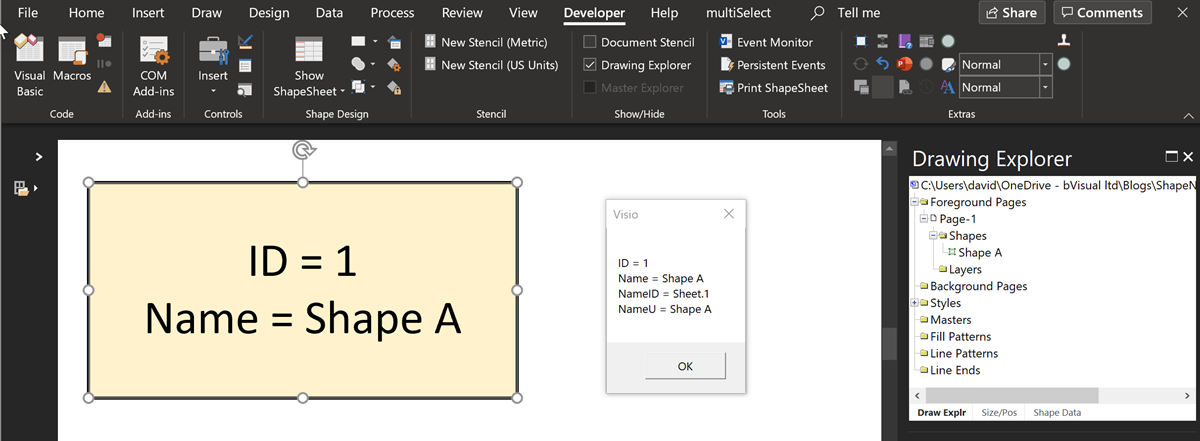Every Visio shape must have a unique name in the collection that it belongs to, and to ensure this, Visio automatically one using the master name or just “Sheet”, if not an instance of a master, followed by a period (“.”) and the ID. However, a user can rename a shape, and Visio will then also update the universal name (NameU) to be the same as the Name. If a user chooses to re-name a shape a second time, then thee universal name is not updated … it remains as the original name.
To demonstrate this I drew a rectangle, then named, and re-named it:
This is the simple VBA code that was called by an Action in the shape:
Public Sub ShapeNames(ByRef shape As Visio.shape)
Dim txt As String
txt = "ID = " & shape.ID
txt = txt & vbCrLf & "Name = " & shape.Name
txt = txt & vbCrLf & "NameID = " & shape.NameID
txt = txt & vbCrLf & "NameU = " & shape.NameU
MsgBox txt
End SubSo, there can be several ways to reference a shape, but be aware when they can be used. For example, the Name cannot be directly typed into a ShapeSheet formula, but the NameU can.
If the NameID is used in a ShapeSheet formula, then it will be automatically re0displayed with the NameU.
Interestingly, either the NameID, NameU or Name can be used if using the EVALTEXT(…) function is used.
In VBA, or other code, then the shape can be referenced by either the NameID or Name, but not by the NameU value. The shape can also be referenced with ID value using the ItemFromID function.
?ActivePage.Shapes("Sheet.1").NameU
Shape A
?ActivePage.Shapes("Shape B").NameU
Shape A
?ActivePage.Shapes.ItemFromID(1).NameU
Shape AIf the Name is deleted using the Shape Name dialog, then the Name is reverted to the NameID, but the NameU still remains unchanged.
The universal name, NameU, was created so that the Visio UI could display a language specific Name value whilst maintaining a language independent NameU in the background.
Code can be used to update the NameU, provided that it is a unique name within the collection.
Every shape can also have a globally unique id (guid for short), which can be created, read or deleted with the various parameters passed to the UniqueID property of a shape (or PageSheet or DocumentSheet). This could be used to name a shape, as in the following VBA code:
Public Sub NameShapesOnPageWithGuid() Dim shp As Visio.Shape For Each shp In ActivePage.Shapes shp.Name = shp.UniqueID(Visio.VisUniqueIDArgs.visGetOrMakeGUID) Debug.Print shp.ID, shp.NameU, shp.Name Next End Sub
This could display something like the following in the Immediate Window:
1755 {04168AB4-2442-40AC-85A2-402B6B6EB97B} {04168AB4-2442-40AC-85A2-402B6B6EB97B}
2067 WBS_2 {14FA6C60-3476-4904-A35C-B4F8568E8EDF}
2070 WBS_2.5 {F7BE8598-C994-4E4B-8691-EDA7573D9D88}
2097 WBS_2.5.2 {53651EEF-1D5D-4C76-8E6B-E09BE036A922}
2112 WBS_2.5.2.1 {E318FC1A-00E5-4062-A62C-480A6E37C77A}
2143 WBS_2.5.2.2 {0DC8C127-5767-430A-B3A2-147E74F50EC6}
2174 WBS_2.5.2.3 {D11417B7-1DAA-4716-AF97-1FC0005E8C12}
2189 WBS_2.5.2.4 {558E05C0-9443-47AA-82E4-4D45866E0CE2}
2073 TASK_1016991 {81F75F38-6AC3-4864-A175-1270F1094EE5}
2077 TASK_1016994 {8CEBD7FE-757D-4A06-816F-3FB112CD0314}
2081 TASK_1017013 {B314B362-7451-4EE3-B9C8-4A38E6DDCDFB}
Notice that the first shape in the list above has the same NameU and Name, but the rest of shapes already had a custom Name, so a second attempt to create a custom Name will not update the NameU property simultaneously. The NameU property can be set in code again, if required, but remember that the Name and NameU values must be unique in the shapes collection that they are part of. In addition, they cannot be a zero-length string.
Synchronizing Visio Shape Fill Color (or almost any cell) across pages
I was recently asked how the color of one shape can be changed and for other shapes to be automatically updated to the same color … even if they are on different pages! Well, it is possible with Microsoft Visio’s awesome ShapeSheet formulas. In fact, this capability is not limited to the FillForegnd cell ……
Positioning Visio Shape Text Block with a Control Handle
I was recently asked how a control handle can be added to a Visio shape so that it can be used to re-position the text block. Fortunately, it is extremely easy to setup, and requires just two formulas to be updated in the ShapeSheet. This is a great use of the SETATREF(…) function. (more…)
Understanding Segments of Visio Geometry
I recently had to revise my understanding of the POINTALONGPATH(…) function in Visio because I was getting a #REF! error in some cases. My particular scenario requires a line with a number of vertices that are initially all in a straight line but can be moved by dragging controls around that each vertex is bound…
Custom Color Themes in Visio?
I was recently looking into custom color themes for corporate branding in desktop Microsoft Visio and became re-aware how different Visio still is from the rest of the Microsoft Office applications. A Visio page or document does not need to have any theme applied, but the documents of the other Office applications always have a…
When is a Visio Callout not a Callout?
I have been a Visio user/developer since the mid-1990’s and seen the word “callout” used as part of the name of many master shapes in Visio. The images below show five ways that the term “callout” has been applied to the name of Visio master shapes. Generally, each evolution has been an advance on the…
Using Visio Color by Value on Connectors
Data Graphics in Visio Plan 2 and Visio Professional is great, but it only enables us to use them with 2D shapes in Visio, i.e. not on connectors. So, what if you want to change the line colour of the connectors between the 2D shapes because of the data flowing between them? Well, it is…
